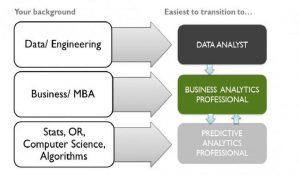In a Forbes article published earlier this year, Piyanka Jain  emphasized the importance of really understanding the landscape for ANALYTICS jobs. Many people confuse terminologies such as big data, business intelligence and analytics and use them synonymously. To clarify, business intelligence includes all components of the operation, from when data is collected to when it is accessed. Analytics is the process performed on data that has been delivered by BI for the purpose of generating insights to drive decisions, actions and, eventually, revenue or other impacts. Big Data’s big three (volumes, variety, and velocity) create issues of storage and visualization that make traditional business intelligence systems unstable. Big Data is thus a business intelligence issue, not an analytics issue. Jain’s article focuses on analytics jobs only.
emphasized the importance of really understanding the landscape for ANALYTICS jobs. Many people confuse terminologies such as big data, business intelligence and analytics and use them synonymously. To clarify, business intelligence includes all components of the operation, from when data is collected to when it is accessed. Analytics is the process performed on data that has been delivered by BI for the purpose of generating insights to drive decisions, actions and, eventually, revenue or other impacts. Big Data’s big three (volumes, variety, and velocity) create issues of storage and visualization that make traditional business intelligence systems unstable. Big Data is thus a business intelligence issue, not an analytics issue. Jain’s article focuses on analytics jobs only.
She outlines the major job categories and identifies the typical skill requirements by the analytics job category.  At the conclusion of the article, she provides advice regarding the ease of the transition into these roles. For professionals with Business Intelligence/Data or Engineering backgrounds (including experience in data structure, information management, data architecture, engineering, etc.), the transition can most easily be made into roles for Data Analyst. For those with a business background (product managers, project managers, MBAs, etc.), consider a Business Analytics position. If past experience has been more focused on statistics, operations research, computer science or algorithms, then a Predictive Analytics job may suit you.
At the conclusion of the article, she provides advice regarding the ease of the transition into these roles. For professionals with Business Intelligence/Data or Engineering backgrounds (including experience in data structure, information management, data architecture, engineering, etc.), the transition can most easily be made into roles for Data Analyst. For those with a business background (product managers, project managers, MBAs, etc.), consider a Business Analytics position. If past experience has been more focused on statistics, operations research, computer science or algorithms, then a Predictive Analytics job may suit you.
Read more of Piyanka Jain’s article here.
